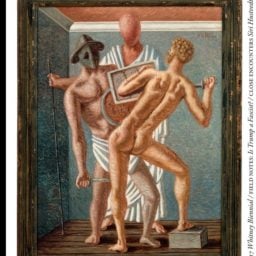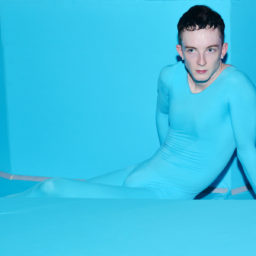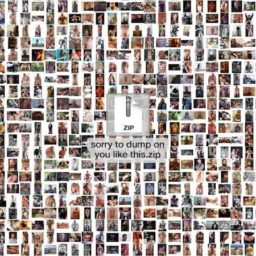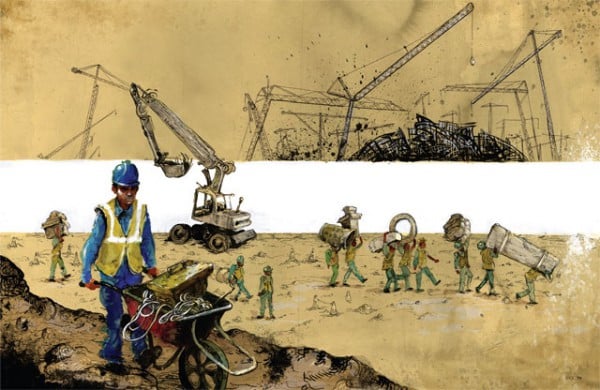

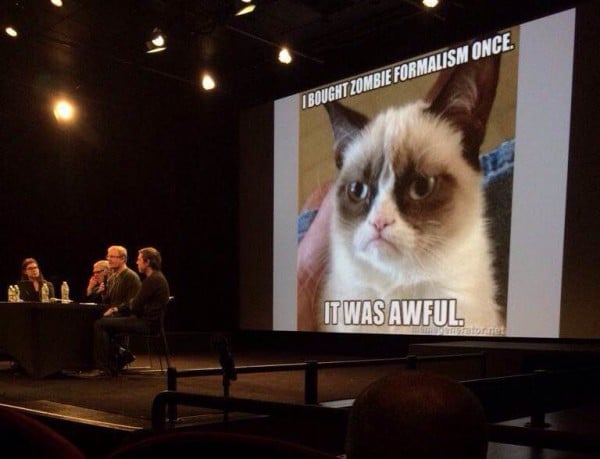
Atmosphere from the Zombie Formalism panel.
It was an eventful year for art writing, with plenty of shifts in the landscape, as new publications opened (including this one), or popped up, or reinvented themselves. But beneath all the institutional shuffles, what were the ideas that got people excited? To try to answer that question, I polled colleagues, but the final selection below is obviously a personal one. It reflects the world around me, and is weighted towards pieces that reflect my own location and my own sense of this year’s troubled qualities. In any case, here are a few of the pieces of writing that I think are touchstones of 2014:
Holland Cotter, “Lost in the Gallery-Industrial Complex,” New York Times, January 17, 2014
It’s a little crazy to me that Cotter’s fretful, sweeping state-of-the-scene piece is already a year old. But it stands in here for all the angst of money in a year of record auction prices and continued angst about inequality.
Jason Farago, “Learning to Live With MoMA,” Frieze blog, January 17, 2014
Amid all the outcry around MoMA’s annexation of the Folk Art Museum building, Farago did the best, to my taste, of getting to the heart of what was really at stake by placing it within the longer arc of change in the museum’s identity going back to its failed encounter with Rem Koolhaas.
Christian L. Frock, “Priced Out: New Tech Wealth and San Francisco’s Receding Art Scene,” KQED, February 7, 2014
Frock’s multipart series (here’s the second: “Priced Out: San Francisco’s Changing Values and Artist Exodus“) captured the voices of a Bay Area arts community trying to stay afloat in a sea of “disruptive” tech money, but testifies to a conversation artists were having seemingly everywhere artists were found (see also Jen Graves’s “How Artists Can Fight Back Against Cities That Are Taking Advantage of Them”).
Trevor Paglen, “Overhead: New Photos of the NSA and Other Top Intelligence Agencies Revealed,” Creative Time Reports, February 10, 2014
If you haven’t been paying attention to what Marisa Mazria Katz has been up to for the last two years at Creative Time Reports—essentially, supporting artists in finding new ways to cover the news—you should be. In February, the publication teamed up with The Intercept to launch this Paglen photo essay, serving up images that immediately became a kind of visual shorthand for the sinister powers of government surveillance in the age of Snowden.
Walter Robinson, “Flippers and the Rise of Zombie Formalism,” Artspace Magazine, April 3, 2014
If there is an essay that touched off more discussion this year, then I can’t think of what it was. The tongue-in-cheek “Zombie Formalism” label, applied either to that funky-junky art-school look or used as a diagnosis of an art world obsessed with “artificial milestones” and the “simulacrum of originality” in general, is now lodged deep in the conversation.
Eunsong Kim and Maya Isabella Mackrandilal, “The Whitney Biennial for Angry Women,” The New Inquiry, April 4, 2014
This unsparing, percussive manifesto denouncing the Biennial and the art establishment in general set the stage for many of the debates of the year. It was, as the authors summed it up in their conclusion, “[a] demand for the impossible: decolonization, decentering, radical thinking, radical action, radical making.”
Helen Molesworth, review of the Whitney Biennial, Artforum, May 2014
The Whitney Biennial always draws fire. But this is really less of a review than a curator’s series of frustrated questions for her peers about the profession and its fundamental aims.
Jamilla King, “The Overwhelming Whiteness of Black Art,” Colorlines, May 21, 2014
This is one from well outside the regular circle of art coverage—but King’s thoughtful piece about Kara Walker’s A Subtlety and the demographics of the art audience opened up a conversation that reverberated throughout the piece’s run, culminating with “We Are Here,” an event for people of color to view Walker’s work together, to experience it as the majority.
Rahel Aima, “Christian Marclay Goes to Bollywood,” The New Inquiry, May 21, 2014
Christian Marclay’s epoch-making The Clock toured the world telling the story of a day through film clips culled mainly from Western film. He follows it up with a supercut of Bollywood dream sequences set in Switzerland, destined to be shown in a chairlift in Gstaad, and Aima considers the cultural asymmetries and structures of power that this makes visible.
Christopher Glazek, “Shopkeepers of the World Unite,” Artforum, June 2014
A sympathetic and convincingly intricate account of the rise of the artists around DIS magazine, making a case for the new Post-Internet cool school while still remaining just critical enough to convince yourself that you were seeing it plain.

Molly Crabapple, illustration for Slaves of Happiness Island.
Courtesy of the artist and Vice
Molly Crabapple, “Slaves of Happiness Island,” Vice, August 4, 2014
A neat feat of first-person journalism, this piece recounts one artist’s voyage onto the site of the soon-to-be built Guggenheim Abu Dhabi to see for herself what labor conditions looked like there. With the main and most demanding construction still to come, Crabapple talked to a worker laying the infrastructure for the new institution: “I don’t know how much longer I can go on like this. My body is on the verge of giving up, but I cannot leave my job because I am responsible for my sisters.”
John Yau, “Andy Warhol and Jeff Koons and the Culture of Hyperbole,” Hyperallergic, August 17, 2014
Taking a long look at the deep values of today’s Koons craze, Yau finds that they amount to this: “to be out of the mainstream is in fact a mark of imperfection.”
Whitney Kimball, “How Do People Feel About the Gramsci Monument, One Year Later?,” Art F City, August 20, 2014
A year after artist Thomas Hirschhorn’s pop-up community center won plaudits and raised hackles at a Bronx housing project, Kimball returns to ask people in the neighborhood what good it left behind—the kind of follow-up that almost never happens. The answers she finds are probably neither positive nor negative enough to satisfy pro-or-anti-Monument camps, which is part of what makes the exercise important.
Carolina Miranda, “Art and race at the Whitney: Rethinking the Donelle Woolford debate,” Los Angeles Times, June 17, 2014
It’s hard to sum up what makes this article important, given everything that’s involved: the Whitney Biennial, a black artist collective’s decision to publicly leave the show in protest of perceived racism, and the artist Joe Scanlan’s work made in the persona of a fictional African-American artist, Donelle Woolford. By interviewing Jenn Kidwell, the actress involved in Scanlan’s work, Miranda added important nuance to a very difficult conversation about race, racism, and art.
Jeff Chang, “Color Theory: Race Trouble and the Avant Garde,” n+1, Fall 2014
Can’t Stop, Won’t Stop author Jeff Chang’s deeply researched, penetrating beat-by-beat account of a 1979 scandal at Artists Space around the artist known as Donald and his so-called “Nigger Drawings” (it’s an excerpt from his new book, Who We Be) unearths all sides of a painful chapter in recent art history. Given the year that we’ve had (see above), its lessons couldn’t feel more relevant.
Assorted essays on contemporary art and feminism, edited by Kara L. Rooney, The Brooklyn Rail, September 2014
There are individual essays here that have stuck with me as offering particularly useful ways to grasp the question of feminism in art today (Chloe Wyma’s “Lean Back: Resisting Branded Feminism” is one that I find myself quoting a lot). But the collection of writings in the Rail‘s special section on the subject is also eclectic, which maybe makes it more useful as a snapshot of the unsettled nature of the present conversation.
Mira Schor, “The Feminist Wheel,” A Year of Positive Thinking, September 20, 2014
An exasperated rant from inside Mira Schor’s head (and Twitter feed) at The Hole’s “Future Feminism” show takes on larger significance as a reflection on the difficulty of staying true to hard-earned—and needed—feminist principles while not missing out on the “utopian ebullience” of more recent arrivals.
Roberta Smith, “In a Mattress, a Lever of Art and Protest,” New York Times, September 21, 2014
In protest over institutional ineptitude around sexual assault, Columbia art student Emma Sulkowicz launched Carry That Weight, vowing to carry a mattress around campus until the man she says raped her leaves. The artistic protest touched off a deafening roar of media coverage of the “hot takes” type—so there was something significant about one of the country’s most authoritative art critics stepping up to explain why this work of protest-as-performance was worth your actual considered attention.
Mostafa Heddaya, “Delusions of Grandeur: GCC at MoMA PS1 and the New Museum,” Hyperallergic, September 26, 2014
This is an adept polemic about the buzzy “Gulf Futurism” of the art group GCC—and through it, a reflection on what strategies of political art might be viable today.
Art Post-Internet, edited by Karen Archey and Robin Peckham, October 2014
If you are one of those people who this year realized that you suddenly had to have something to say about “Post-Internet” art, this sprawling pamphlet with contributions from artists, academics, curators, and writers (including me) is as fine a place to start as any. In a neat Post-Internet touch, each PDF is a “unique” edition, stamped with a number and record of your location and the weather where you were at the moment you hit download.
Andrew Berardini, “How to Write About Contemporary Art,” Momus, October 15, 2014
This year, Toronto-based writer Sky Goodden launched Momus.ca, an online art platform that bills itself as a “return to art criticism.” Berardini’s essay on the petty indignities and strange detours of a life of writing about art is probably my favorite piece on this list. I can’t do it justice, so just go read it.
Brian Droitcour, “The Perils of Post-Internet Art,” Art in America, November 2014
You know something has become a thing when it starts to draw the kind of sustained intellectual attack that Droitcour levels at the avatars of Post-Internet art, framing the whole trend as an attempt to recapture the web’s anarchic energies for the professional gallery world rather than a step into some new realm beyond it.
Philip Kennicott, “An art loan from Bill Cosby draws the Smithsonian into a national debate,” The Washington Post, November 20, 2014; Jillian Steinhauer, “What Should the Smithsonian Do About Its Show of Bill Cosby’s Art Collection?,” Hyperallergic, November 20, 2014; Kriston Capps, “Why Is the Smithsonian Standing Behind Bill Cosby?,” The Atlantic, November 21, 2014
The fallout from the allegations against Bill Cosby is far from over, but at year’s end, it provoked a series of excellent articles that went beyond the immediate scandal to look at the responsibilities of art institutions and the ethical traps of showcasing private collections.
Victor Merida, “Excited Delirium: Graffiti and Miami,” The Miami Rail, Winter 2014
Some sober, sobering reflections on graffiti art’s place in the branding of Miami, made more resonant by the tragic death of the young artist Israel “REEFA” Hernandez last year at the hands of the police.
Pac Pobric, “Sturtevant’s Provincialism,” Los Angeles Review of Books, December 18, 2014
There’s just something about a righteously pissed-off review, right? And while this year will be remembered as one where everyone once again proved their seriousness by lining up to take shots at Jeff Koons, here’s one that goes after a target that’s more difficult to pin down.
Mel Chin, “Miley, Eric and Me: Basel’s Dazzle and the Dark Death Around Us,” Creative Time Reports, December 18, 2014
I’m not sure I could believe that anything that great came of Miley Cyrus’s coronation as an art star at Art Basel in Miami Beach. But this soul-searching essay did come of it, which is definitely worth something.
Special mentions:
W.A.G.E. Wo/Manifesto
This is a bullet-pointed call for change, from the group that calls for a new social contract between art institutions and artists.
Not That This!
Nathaniel Donnett’s blog focusing on adding coverage of the African-American art scene in Houston not only adds a needed perspective, but does so in experimental ways; for instance, using poetry. It just won an Idea Fund grant to expand and make its coverage more regular, so keep it bookmarked.
Christian Viveros-Fauné and Blake Gopnik, “Strictly Critical” video series, artnet News, and Casey Jane Ellison, “Touching the Art,” Ovation TV
Having seen many, many attempts to make art-themed videos work over the years, I know how hard it is—but this year brought two strong contenders. Viveros-Fauné and Gopnik perfected a Siskel and Ebert routine that made it seem suddenly fun and interesting to debate art, not a chore. Meanwhile, Ellison, whose Twitter bio describes herself as “artist + comic with a mole on her face,” brought her own alluringly wacky touch to bear on Ovation’s art-themed chat show.
Raphael Rubinstein, The Miraculous (Paper Monument)
Here’s another outlier because it is a book and not an essay, strictly speaking, which opens up a whole other can of worms. But, in terms of things I read this year that really made me rethink how I looked at contemporary art, this one particularly affected me. So it stays on! If you still need a gift for an art lover, this is it.
Follow Artnet News on Facebook:
Want to stay ahead of the art world? Subscribe to our newsletter to get the breaking news, eye-opening interviews, and incisive critical takes that drive the conversation forward.

